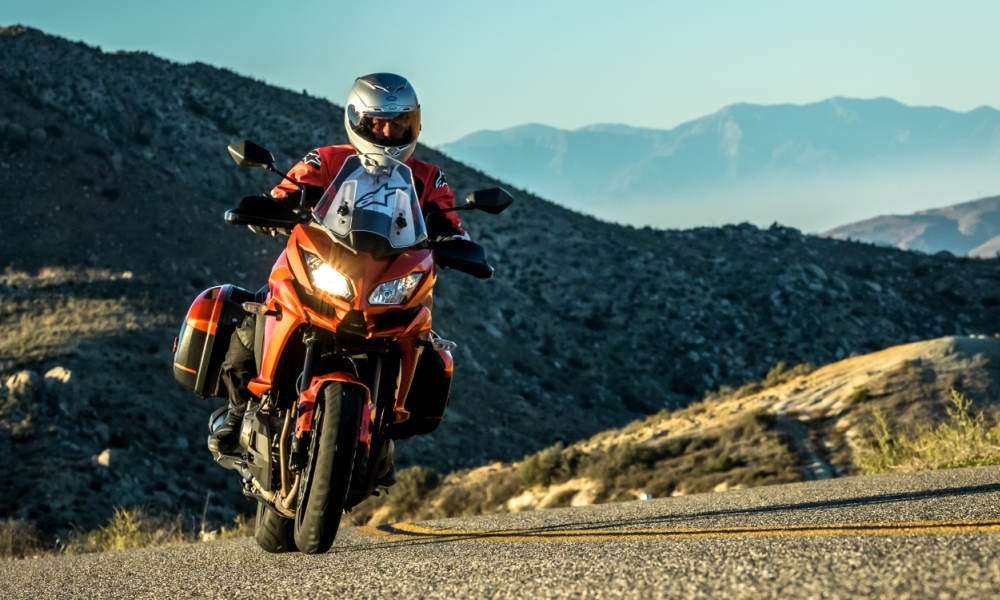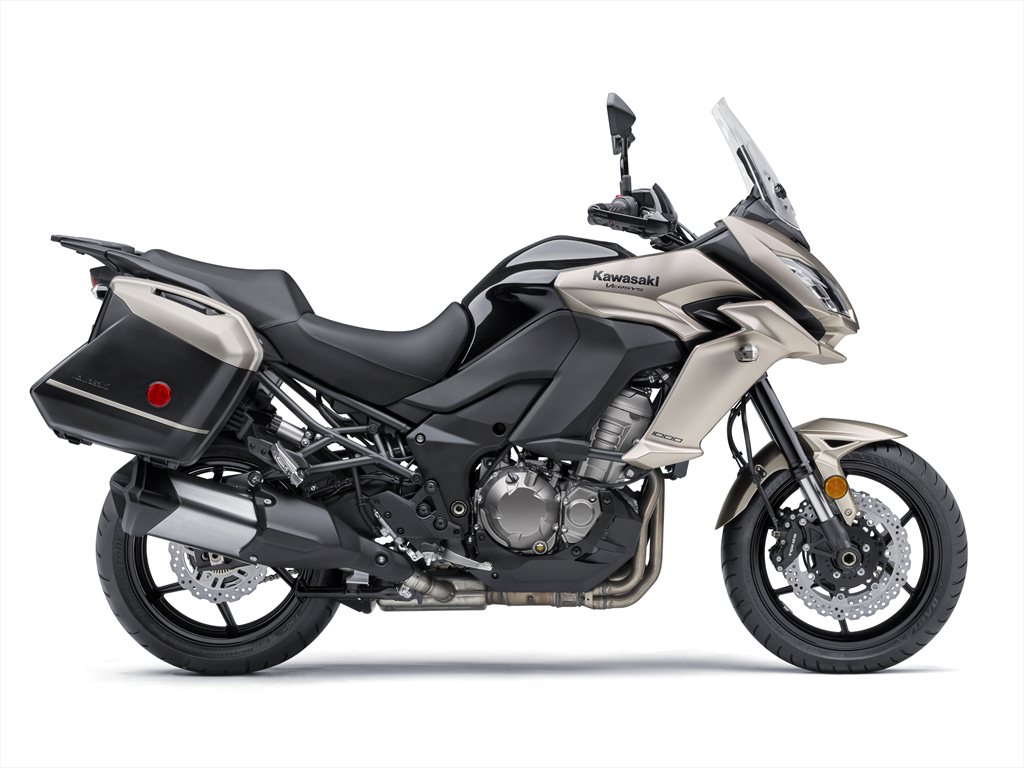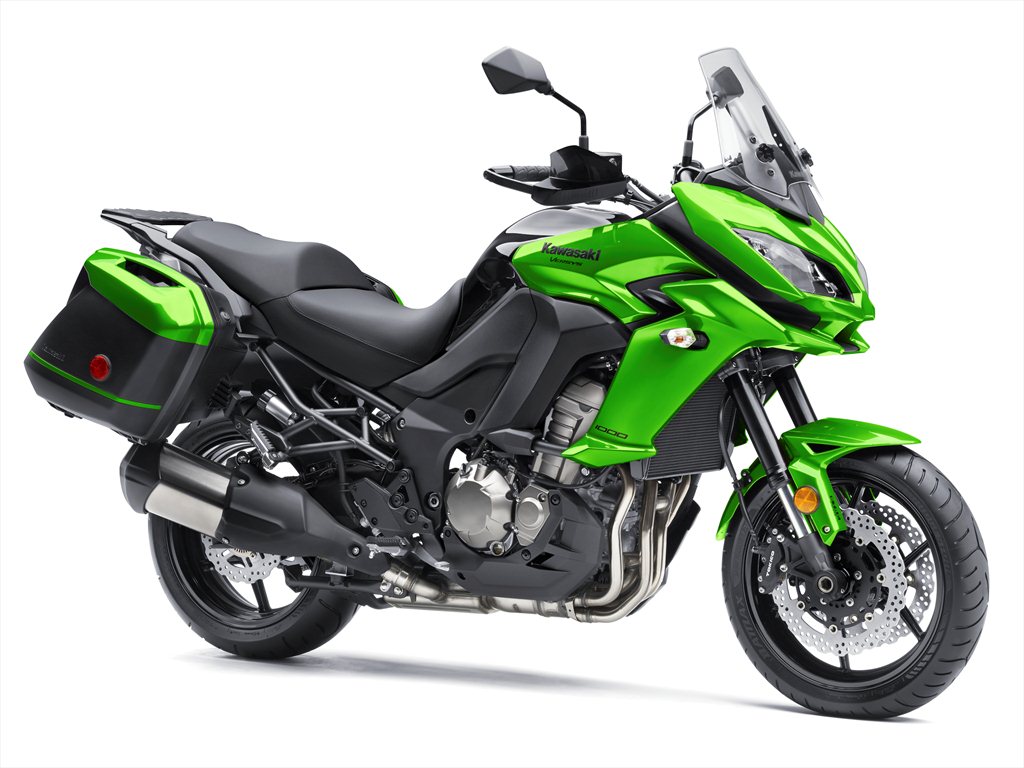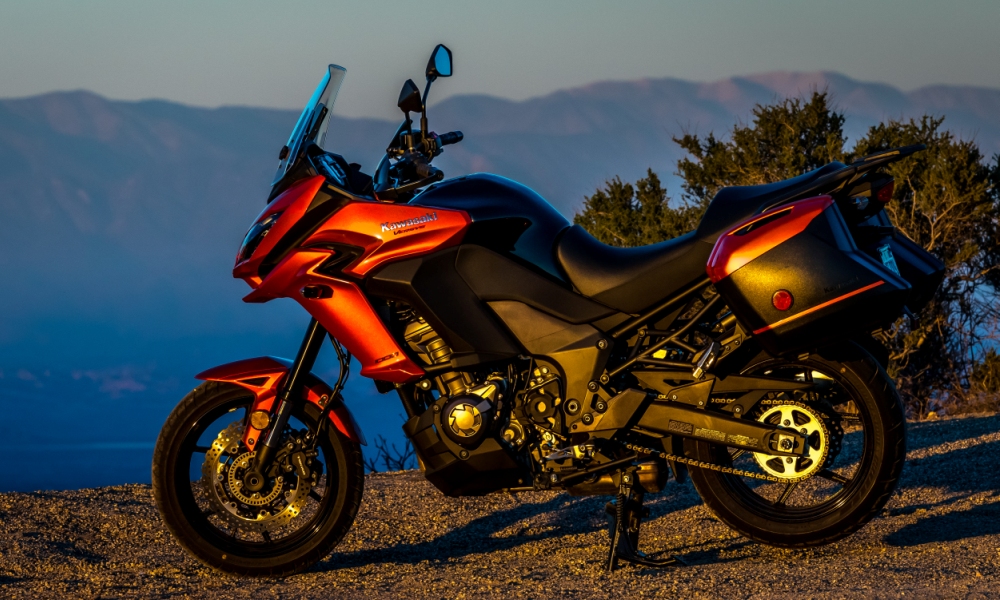
The Versys 1000 LT came to the United States in 2015 after being first available in Europe. As a long-time Versys 650 owner, I spent a week on the big brother to see how it measures up. Photo by Scott Sorenson.
About 13 years ago, my wife saw a TV travel show about a place in Saint George, Utah, called the Red Mountain Resort. At the time, she was a mid-life grad school student dreaming of a spa getaway with her girlfriends. Now that she’s the associate provost of her college, she decided it was finally time to indulge that old fantasy, so we planned a trip around her birthday.
Of course I had to find a way to squeeze some motorcycling into the excursion, so I hatched a plan that involved me flying to Southern California before heading east to meet her. From the start, I knew exactly which motorcycle I wanted to borrow for this mission: the Kawasaki Versys 1000 LT.
Why? Several reasons.
First, I knew it would be capable and comfortable enough for us to do a little two-up riding, but sporty enough that I wouldn’t feel like I was a barge pilot for the majority of the trip, when I was riding alone. Second, I knew there was interest in the bike among our readers at RevZilla’s Common Tread. And finally, as a long-time Versys 650 owner, I was very curious to see if Kawasaki could supersize a bike known for being nimble and fun to ride without losing those positive qualities.
The Kawasaki Versys 1000 LT: the facts

If green is not your thing, Kawasaki also offers the combination of “metallic raw titanium and metallic spark black.” I was impressed with the paint and the fit and finish in general, given the price.

The orange version I rode was a 2015 model. For 2016, Kawasaki offers two color schemes in the United States, including this “candy lime green and metallic spark black” combination.
While the 650 cc Versys comes in regular and LT models, the Versys 1000 is available in the United States only in the LT form. That means it comes well equipped for touring, with a surprising number of features for the price ($12,799 MSRP for 2015, $12,999 for 2016). The standard equipment includes ABS, two power modes and three levels of KTRC (Kawasaki’s traction control), Kawasaki’s assist and slipper clutch, nicely integrated 28-liter color-matched panniers that open and remove using the ignition key, a center stand, a manually adjustable windscreen, handguards and adjustable levers for both clutch and brake. While some of its European competitors, such as the Ducati Multistrada and BMW S 1000 XR, offer sophisticated options such as dynamic suspension and cruise control, those bikes also come with much higher price tags. Equipped with panniers, like the Versys, they top $19,000. The Versys 1000 LT gives you a lot for your money.
The Versys is powered by the same 1,043 cc inline four-cylinder engine found in Kawasaki’s Ninja 1000 and Z1000, but the engine is retuned in the Versys. The Versys also gets taller gearing in the top two gears, compared to its two liter-class siblings, to contribute to its touring ability.
The Versys 1000 LT is part of the new class of sport-touring machines that mixes the stance and stature of adventure-touring bikes with running gear that’s aimed strictly at on-pavement use. To me, the key dividing feature is the 17-inch wheels in sporty sizes. The Versys uses a 120/70-17 tire in front and a 180/55-17 in the rear, giving the rider a wide choice of sport and sport-touring rubber. Bikes like the BMW R 1200 GS or the new Honda Africa Twin that still harbor off-road ambitions come with 19-inch or 21-inch front wheels, suitable for dual-sport tires. Still, the Versys provides a full 5.9 inches of suspension travel at both ends and the seat height is a relatively high 33.1-inch seat. That and the bolt-upright riding position show its adventure-touring influences.
With the saddlebags attached, the Versys 1000 LT weighs about 570 pounds, according to Kawasaki. The nimble handling of the original Versys 650 was one of the characteristics that won it awards from motorcycle magazines and websites. It’s also one of the attributes I’ve appreciated while putting 56,000 miles on my personal Versys. As I set out on my trip, I was curious above all to see if the taller, heavier 1000 could retain that agile feel, despite its greater height and weight. Could the original Versys be supersized without feeling like a supertanker?
The Versys 1000 LT in Joshua Tree National Park.
The Kawasaki Versys 1000 LT: the ride
The 28-liter panniers come standard on the LT and tuck in nicely, but lane-splitters must be aware they are still wider than the handlebars. They open easily and remove without too much difficulty, using the same key as the ignition.
After picking up the bike at Kawasaki headquarters in Irvine, Calif., I took a scenic and circuitous route to Las Vegas, where I picked up my wife at the airport, and we continued on to Utah. After an interlude at the resort, we visited Zion National Park and I dropped her off in Vegas before returning to California. In total, I rode the Versys 1,382 miles, more than 250 of them two-up, in all kinds of situations and conditions: from sport riding solo through the hairpins of California Route 74 heading down from the mountains into Palm Desert to two-up on the wide-open stretches of I-15; battling SoCal freeway traffic and cruising the peaceful roads through Joshua Tree National Park; from 41 early-morning degrees leaving Saint George to 94 degrees six hours later in Corona, Calif.
With the saddlebags removed, the mounts are hardly noticeable.
In all those conditions, the Versys pleasantly surprised me with its competence. There’s nothing really groundbreaking or stunning about this motorcycle, but there’s simply nothing wrong with it. The engine is the centerpiece of any motorcycle, and it sets the tone for the kind of steady competence I’m talking about.
Kawasaki retuned the 1,043 cc engine slightly for use in the Versys. That results in peak horsepower figures in the 110 range, based on the dyno charts I’ve seen. By itself, that’s not an impressive number, which is probably why Kawasaki didn’t list it on the spec sheet, choosing instead to highlight the torque peak of 75.2 foot-pounds at 7,500 rpm. My old Triumph Daytona 675 makes almost as much peak horsepower as the much larger Versys.
As a sport-touring mount, however, the Versys is not about peak horsepower. By not tuning the engine for maximum power at high revs, the Kawasaki engineers were able to focus on giving the bike smooth power no matter where you are on the tach. When I was maneuvering around a parking lot at low speeds, there was very little of the on-off throttle abruptness that plagues so many powerful bikes, but when I needed to accelerate to merge into the endless stream of traffic on a SoCal freeway, a smooth surge of power was always available. Are you looking for that insane hit of power that comes on at five-digit rpms and distorts your vision as it flattens your eyeballs? Look at a ZX-10R or a ZX-14R. Want a broad spread of power that’s usable on the street? Consider the Versys.
From the first time I pulled in the clutch, I was impressed with the light effort provided by the assist and slipper clutch, which also prevented any rear-wheel lockup or hopping. The other controls were well placed and easy to use and toggling through the displays on the LCD screen or changing the KTRC settings and power modes was easy to figure out. The display provided lots of information — basically everything I wanted to know except which gear I was in. Given the nature of the engine, I could often be in any one of three different gears, and it didn’t much matter, but that just means I often lost track and a display would have been nice. The only places where the Versys ever looked cheap were a few plastic fasteners and some blank spots on the dash where we U.S. consumers were clearly lacking accessories offered in Europe. Otherwise, the fit and finish positively surprised me and the various metallic paint offerings from Kawasaki really catch the sunlight and look nice.
The windscreen provides about three inches of adjustment range and can be changed without tools by loosening the two clamps on the front. Raising it increased wind protection for my shoulders at the cost of greater buffeting. I ended up riding with it in the lowest position most of the time.
The Versys 1000 LT was a comfortable and capable mount for two-up riding, though I wished for a little more stiffness in the rear suspension with the bike loaded.
The rider’s seat is broad and comfortable, though it has the common problem of sloping forward. I was able to ride farther without complaint than I usually can on a stock seat. The passenger seat, if anything, is even better. My wife liked everything about the passenger accommodations, from the seat to the leg room to the wind protection, except she felt the grab handles were too thick for comfort. Could that be a Kawasaki problem or could it be because she wears size XS gloves?
Because I was riding most of the trip solo, but my wife was joining me for part of the ride, I was happy to see the remote rear preload adjuster on the Versys. Unfortunately, when I went to add preload, I couldn’t turn the adjuster. I even dug out the manual to see if I was missing a step. After an embarrassingly long time, I figured out the problem. The adjustment was already maxed out. But with two of us on board and the saddle bags full, I still wanted more stiffness at the back end.
Similarly, while the long-travel fork soaks up bumps admirably, it started to wallow a little when I picked up the pace among the curves and hairpins on Route 74. That softness at both ends is the price to be paid for the adventure-bike stance and comfortable ride. Is it a problem? That depends on how you ride. And if you ride hard enough and fast enough often enough that it does bother you, then you may not be shopping in the Versys aisle of your Kawasaki dealer anyway. May I recommend something with a Ninja name on it? Maybe — if you’re still into sport-touring — the Ninja 1000 that shares the same engine but feels surprisingly different.
At the end of my trip, I met up with an old friend in the business to talk shop. He’s a very experienced motorcycle writer who has ridden just about everything, and when I told him I’d been riding the Versys 1000 LT and the Ninja 1000, he said, “The Versys is a better bike, isn’t it?” When I hesitated, he asked, “Which one would you buy?”
Those are really two different questions. Yes, I agree with him that the Versys is a slightly better motorcycle. But which one I would buy? That’s a different question.
The main reason you might not buy the Versys is that it just doesn’t fit you. There are plenty of cruisers and touring bikes that weigh significantly more than the Versys’ 570 pounds, and there are dual-sport and adventure bikes that have taller seat heights. There are only a few bikes, however, that have both. Riding the Versys doesn’t feel like wrestling a bull. The high and wide handlebar provides leverage, and it retains enough family resemblance to the original, smaller Versys to be a good-handling motorcycle, though the word “nimble” won’t be tossed around as often as it is with the 650. The Versys 1000 LT doesn’t feel like a heavyweight. But neither does it ever feel like a lightweight.
And that’s where my hesitation comes in. I’d happily give up the extra suspension travel for a little more sportiness and agility. I guess I’m not personally sold on the entire adventure-bike-as-sport-touring-bike theme, even though that’s where the action is these days. Just as, in the car world, people migrated from SUVs to crossovers, riders are moving from adventure-touring motorcycles to their thoroughly street-going counterparts, upright bikes like the Versys 1000 LT, the Yamaha FJ-09, the Multistrada, the S 1000 XR, the Aprilia Caponord and the forthcoming KTM Super Duke GT. I may be out of step with the times, but I still envision the ultimate sport-touring motorcycle as a sport bike made comfortable and equipped with luggage, rather than a tall adventure bike with 17-inch wheels and other street-focused parts.

I was pleasantly surprised by the fit and finish and the paint on the Versys. Photo by Scott Sorenson.
I can’t say there’s anything wrong with the Versys, unless it just plain doesn’t fit you. When I’m doing a 600-mile day, what I look for in a motorcycle is smooth, drama-free competence, and that’s what the Versys 1000 LT delivers, at a lower price than most of its direct competitors. If you’re unlike me, and you like the ergonomics and stance of the new breed of sport-touring bikes derived from the adventure world, there’s no reason not to buy one and plenty of reasons why this is among the very best bargains in sport-touring motorcycles today.

Good writeup. What kind of range and mileage does it get?
I saw mileage in the mid 40s mpg on highway runs. It’s the 70 mph highway runs where the mileage suffers on my Versys 650, because the engine is spinning pretty fast, but the Versys 1000 LT is just loping along in sixth gear without breaking a sweat. I actually think in those scenarios the Versys 1000 will get equal or maybe better mileage than the 650.
The tank on the Versys 1000 is 5.5 gallons, so you easily have a 200-mile range.